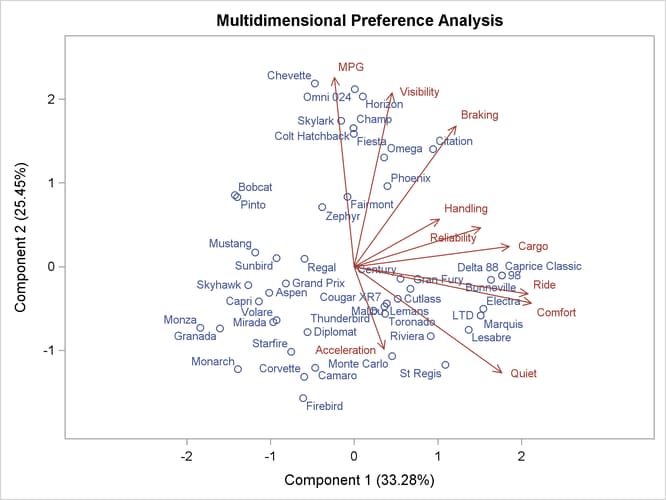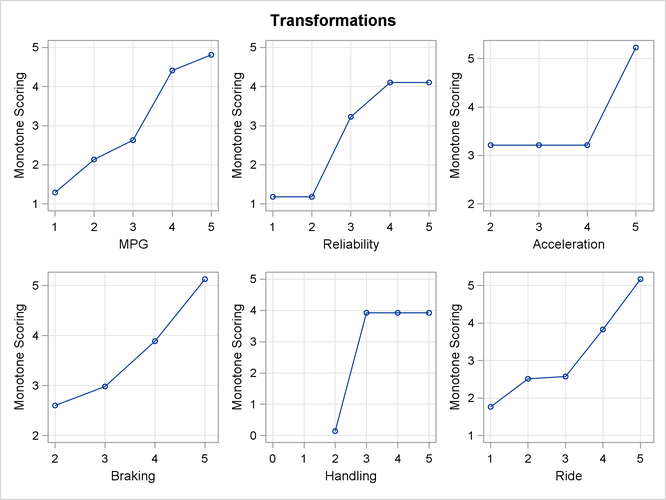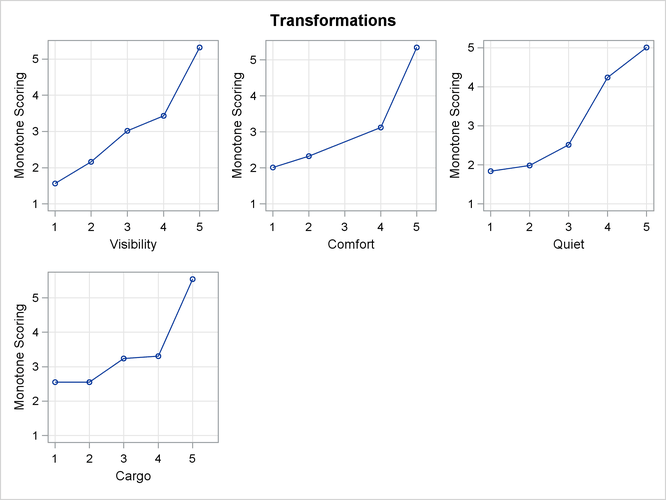The PRINQUAL Procedure
- Overview
- Getting Started
-
Syntax

-
Details
 The Three Methods of Variable TransformationUnderstanding How PROC PRINQUAL WorksSplinesMissing ValuesControlling the Number of IterationsPerforming a Principal Component Analysis of Transformed DataUsing the MAC MethodOutput Data SetAvoiding Constant TransformationsConstant VariablesCharacter OPSCORE VariablesREITERATE Option UsagePassive ObservationsComputational ResourcesDisplayed OutputODS Table NamesODS Graphics
The Three Methods of Variable TransformationUnderstanding How PROC PRINQUAL WorksSplinesMissing ValuesControlling the Number of IterationsPerforming a Principal Component Analysis of Transformed DataUsing the MAC MethodOutput Data SetAvoiding Constant TransformationsConstant VariablesCharacter OPSCORE VariablesREITERATE Option UsagePassive ObservationsComputational ResourcesDisplayed OutputODS Table NamesODS Graphics -
Examples

- References
PROC PRINQUAL can be used to fit a principal component model with nonlinear transformations of the variables and graphically display the results. This example finds monotonic transformations of ratings of automobiles.
title 'Ratings for Automobiles Manufactured in 1980';
data cars;
input Origin $ 1-8 Make $ 10-19 Model $ 21-36
(MPG Reliability Acceleration Braking Handling Ride
Visibility Comfort Quiet Cargo) (1.);
datalines;
GMC Buick Century 3334444544
GMC Buick Electra 2434453555
GMC Buick Lesabre 2354353545
GMC Buick Regal 3244443424
... more lines ...
GMC Pontiac Sunbird 3134533234
;
ods graphics on; proc prinqual data=cars plots=all maxiter=100; transform monotone(mpg -- cargo); id model; run;
The PROC PRINQUAL statement names the input data set Cars. The ODS GRAPHICS statement, along with the PLOTS=ALL option, requests all graphical displays. The MDPREF option requests
the PCA plot with the scores (automobiles) represented as points and the structure (variables) represented as vectors. By
default, the vector lengths are increased by a factor of 2.5 to produce a better graphical display. If instead you were to
specify MDPREF=1, you would get the actual vectors, and they would all be short and would end near the origin where there
are a lot of points. It is often the case that increasing the vector lengths by a factor of 2 or 3 makes a better graphical
display, so by default the vector lengths are increased by a factor of 2.5. Up to 100 iterations are requested with the MAXITER=
option. All of the numeric variable are specified with a MONOTONE transformation, so their original values, 1 to 5, are optimally
rescored to maximize fit to a two-component model while preserving the original order. The Model variable provides the labels for the row points in the plot.
The iteration history table is shown in Figure 80.1. The monotonic transformations allow the PCA to account for 5% more variance in two principal components than the ordinary PCA model applied to the untransformed data.
Figure 80.1: Automobile Ratings Iteration History
| Ratings for Automobiles Manufactured in 1980 |
| PRINQUAL MTV Algorithm Iteration History | |||||
|---|---|---|---|---|---|
| Iteration Number |
Average Change |
Maximum Change |
Proportion of Variance |
Criterion Change |
Note |
| 1 | 0.18087 | 1.24219 | 0.53742 | ||
| 2 | 0.06916 | 0.77503 | 0.57244 | 0.03502 | |
| 3 | 0.04653 | 0.38237 | 0.57978 | 0.00734 | |
| 4 | 0.03387 | 0.18682 | 0.58300 | 0.00321 | |
| 5 | 0.02661 | 0.13506 | 0.58484 | 0.00185 | |
| 6 | 0.01730 | 0.09213 | 0.58600 | 0.00115 | |
| 7 | 0.00969 | 0.07107 | 0.58660 | 0.00061 | |
| 8 | 0.00705 | 0.04798 | 0.58685 | 0.00025 | |
| 9 | 0.00544 | 0.03482 | 0.58699 | 0.00014 | |
| 10 | 0.00442 | 0.02641 | 0.58708 | 0.00009 | |
| 11 | 0.00363 | 0.02062 | 0.58714 | 0.00006 | |
| 12 | 0.00298 | 0.01643 | 0.58717 | 0.00004 | |
| 13 | 0.00245 | 0.01325 | 0.58720 | 0.00002 | |
| 14 | 0.00201 | 0.01077 | 0.58721 | 0.00002 | |
| 15 | 0.00165 | 0.00880 | 0.58723 | 0.00001 | |
| 16 | 0.00136 | 0.00721 | 0.58723 | 0.00001 | |
| 17 | 0.00112 | 0.00591 | 0.58724 | 0.00001 | |
| 18 | 0.00092 | 0.00485 | 0.58724 | 0.00000 | |
| 19 | 0.00075 | 0.00399 | 0.58724 | 0.00000 | |
| 20 | 0.00062 | 0.00328 | 0.58725 | 0.00000 | |
| 21 | 0.00051 | 0.00269 | 0.58725 | 0.00000 | |
| 22 | 0.00042 | 0.00221 | 0.58725 | 0.00000 | |
| 23 | 0.00035 | 0.00182 | 0.58725 | 0.00000 | |
| 24 | 0.00028 | 0.00149 | 0.58725 | 0.00000 | |
| 25 | 0.00023 | 0.00123 | 0.58725 | 0.00000 | |
| 26 | 0.00019 | 0.00101 | 0.58725 | 0.00000 | |
| 27 | 0.00016 | 0.00083 | 0.58725 | 0.00000 | |
| 28 | 0.00013 | 0.00068 | 0.58725 | 0.00000 | |
| 29 | 0.00011 | 0.00056 | 0.58725 | 0.00000 | |
| 30 | 0.00009 | 0.00046 | 0.58725 | 0.00000 | |
| 31 | 0.00007 | 0.00038 | 0.58725 | 0.00000 | |
| 32 | 0.00006 | 0.00031 | 0.58725 | 0.00000 | |
| 33 | 0.00005 | 0.00025 | 0.58725 | 0.00000 | |
| 34 | 0.00004 | 0.00021 | 0.58725 | 0.00000 | |
| 35 | 0.00003 | 0.00017 | 0.58725 | 0.00000 | |
| 36 | 0.00003 | 0.00014 | 0.58725 | 0.00000 | |
| 37 | 0.00002 | 0.00012 | 0.58725 | 0.00000 | |
| 38 | 0.00002 | 0.00010 | 0.58725 | 0.00000 | |
| 39 | 0.00001 | 0.00008 | 0.58725 | 0.00000 | |
| 40 | 0.00001 | 0.00006 | 0.58725 | 0.00000 | |
| 41 | 0.00001 | 0.00005 | 0.58725 | 0.00000 | |
| 42 | 0.00001 | 0.00004 | 0.58725 | 0.00000 | Converged |
The PCA biplot in Figure 80.2 shows the transformed automobile ratings projected into the two-dimensional plane of the analysis. The automobiles on the left tend to be smaller than the autos on the right, and the autos at the top tend to be cheaper than the autos at the bottom. The vectors can help you interpret the plot of the scores. Longer vectors show the variables that better fit the two-dimensional model. A larger component of them is in the plane of the plot. In contrast, shorter vectors show the variables that do not fit the two-dimensional model as well. They tend to be located less in the plot and more away from the plot; hence their projection into the plot is shorter. To envision this, lay a pencil on your desk directly under a light, and slowly rotate it up to form a 90-degree angle with your desk. As you do so, the shadow or projection of the pencil onto your desk will get progressively shorter. The results show, for example, that the Chevette would be expected to do well on gas mileage but not well on quiet and acceleration. In contrast, the Corvette and the Firebird have the opposite pattern.
There are many patterns shown in the transformations in Figure 80.3. The transformation of Braking, for example, is not very different from the original scoring. The optimal scoring for other variables, such as Acceleration and Handling, is binary. Automobiles are differentiated by high versus everything else or low versus everything else.


